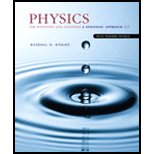
Concept explainers
A chemist identifies compounds by identifying bright lines in their spectra. She does so by healing the compounds until they glow, sending the light through a diffraction grating, and measuring the positions of first-order spectral lines on a detector 15.0 cm behind the grating. Unfortunately, she has lost the card that gives the specifications of the grating. Fortunately, she has a known compound that she can use to calibrate the grating. She heats the known compound, which emits light at a wavelength of 461 nm, and observes a spectral line 9.95 cm from the center of the diffraction pattern. What are the wavelengths emitted by compounds A and B that have spectral lines detected at positions 8.55 cm and 12.15 cm, respectively?
Want to see the full answer?
Check out a sample textbook solution
Chapter 33 Solutions
Physics for Scientists and Engineers: A Strategic Approach with Modern Physics (4th Edition)
- Solve and answer correctly please.Thank you!!arrow_forwardA cart on wheels (assume frictionless) with a mass of 20 kg is pulled rightward with a 50N force. What is its acceleration?arrow_forwardTwo-point charges of 5.00 µC and -3.00 µC are placed 0.250 m apart.a) What is the electric force on each charge? Include strength and direction and a sketch.b) What would be the magnitude of the force if both charges are positive? How about the direction? c) What will happen to the electric force on each piece of charge if they are moved twice as far apart? (Give a numerical answer as well as an explanation.)arrow_forward
- y[m] The figure shows two snapshots of a single wave on a string. The wave is traveling to the right in the +x direction. The solid line is a snapshot of the wave at time t=0 s, while the dashed line is a snapshot of the wave at t=0.48s. 0 0.75 1.5 2.25 3 8 8 6 6 4 2 4 2 0 -2 -2 -4 -4 -6 -6 -8 -8 0 0.75 1.5 2.25 3 x[m] Determine the period of the wave in units of seconds. Enter your numerical answer below including at least 3 significant figures. Do not enter a fraction, do not use scientific notation.arrow_forwardNo chatgpt pls will upvotearrow_forwardAn extremely long, solid nonconducting cylinder has a radius Ro. The charge density within the cylinder is a function of the distance R from the axis, given by PE (R) = po(R/Ro)², po > 0.arrow_forward
- An extremely long, solid nonconducting cylinder has a radius Ro. The charge density within the cylinder is a function of the distance R from the axis, given by PE (R) = po(R/Ro)², po > 0.arrow_forwardA sky diver of mass 90 kg (with suit and gear) is falling at terminal speed. What is the upward force of air drag, and how do you know?arrow_forwardA car is traveling at top speed on the Bonneville salt flats while attempting a land speed record. The tires exert 25 kN of force in the backward direction on the ground. Why backwards? How large are the forces resisting the forward motion of the car, and why?arrow_forward
 Modern PhysicsPhysicsISBN:9781111794378Author:Raymond A. Serway, Clement J. Moses, Curt A. MoyerPublisher:Cengage Learning
Modern PhysicsPhysicsISBN:9781111794378Author:Raymond A. Serway, Clement J. Moses, Curt A. MoyerPublisher:Cengage Learning College PhysicsPhysicsISBN:9781285737027Author:Raymond A. Serway, Chris VuillePublisher:Cengage Learning
College PhysicsPhysicsISBN:9781285737027Author:Raymond A. Serway, Chris VuillePublisher:Cengage Learning Physics for Scientists and Engineers: Foundations...PhysicsISBN:9781133939146Author:Katz, Debora M.Publisher:Cengage Learning
Physics for Scientists and Engineers: Foundations...PhysicsISBN:9781133939146Author:Katz, Debora M.Publisher:Cengage Learning University Physics Volume 3PhysicsISBN:9781938168185Author:William Moebs, Jeff SannyPublisher:OpenStax
University Physics Volume 3PhysicsISBN:9781938168185Author:William Moebs, Jeff SannyPublisher:OpenStax College PhysicsPhysicsISBN:9781305952300Author:Raymond A. Serway, Chris VuillePublisher:Cengage Learning
College PhysicsPhysicsISBN:9781305952300Author:Raymond A. Serway, Chris VuillePublisher:Cengage Learning Principles of Physics: A Calculus-Based TextPhysicsISBN:9781133104261Author:Raymond A. Serway, John W. JewettPublisher:Cengage Learning
Principles of Physics: A Calculus-Based TextPhysicsISBN:9781133104261Author:Raymond A. Serway, John W. JewettPublisher:Cengage Learning





